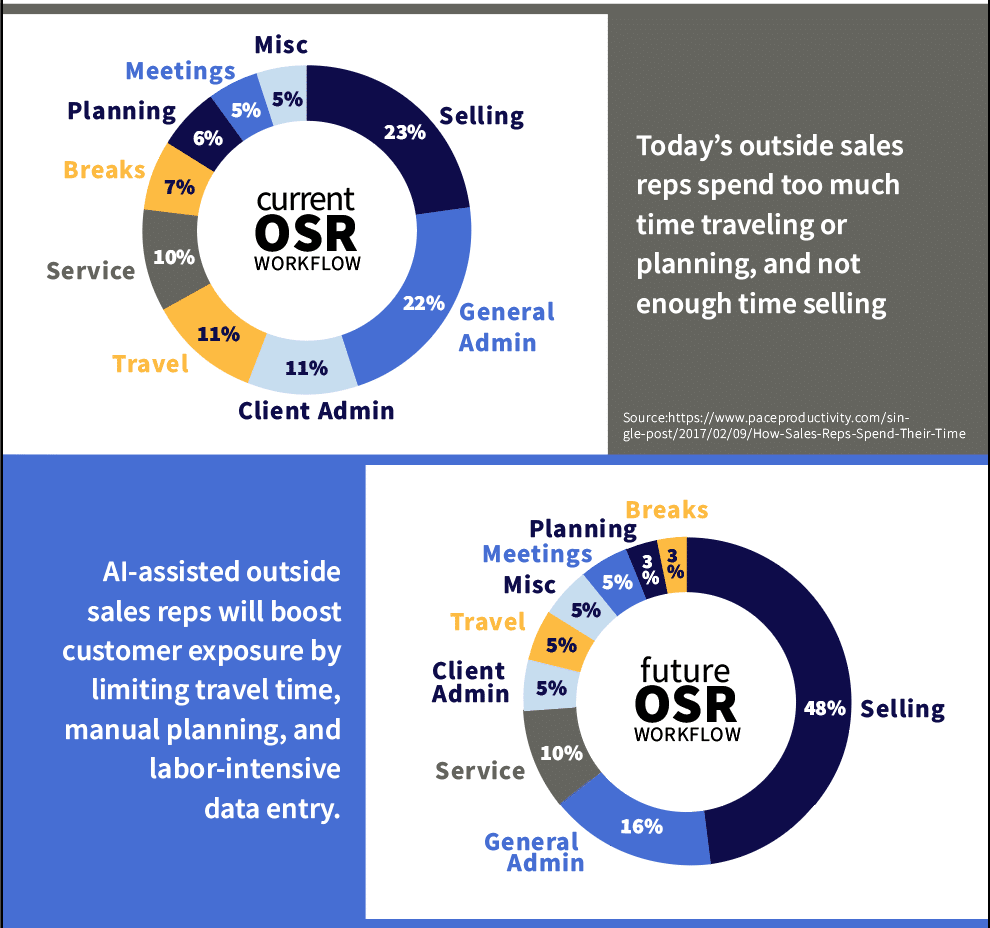Over the past few months, COVID has dramatically redefined the role of outside sales representatives. As reps have been forced to exit the field in some cases, more than 90% of B2B companies have shifted to a virtual or hybridized sales model. While distributors have struggled, many others have found temporary ways to adapt.
As markets stabilize, however, distributors will need to move past loss-prevention mode and back into strategic-growth mode. To do this, they will need to stop merely coping with the new rules of outside sales, and start actively exploiting them. This article will explain why hybrid models are ideal for this new sales landscape, how outside sales reps are primed to dominate this disrupted environment, and what tools they’ll need to do it.
COVID: Calamity or Catalyst?
COVID has undeniably disrupted the way we buy and sell. But whether this change is a positive or a negative depends on how your business responds. Distributors who use COVID as an opportunity to create a better sales model will win out in the long run.
In a 2013 Harvard Business Review article, B2B sales leader Mike Moorman explained that companies were transitioning to inside sales reps over outside sales for three reasons. First, inside sales is a more cost-effective option for companies seeking to cut costs. Second, B2B buyers were becoming more comfortable with remote purchases. Third, better technology like videoconferencing was shrinking the quality gap between remote and personal interactions.
While businesses have been slowly adapting to these conditions over the past seven years, COVID has dramatically accelerated the rate of change. Today’s companies are under extreme pressure to be cost-efficient. Today’s buyers have no choice but to accept remote purchasing. And nearly everyone accepts communications technology like Zoom as a substitute for personal sales.
In short, instead of creating new market pressures, COVID has simply amplified pre-existing trends. Rather than fighting this, businesses must use this crisis as a positive impetus for change. That doesn’t mean that businesses should scrap outside sales in favor of inside reps, but it does mean that the role of the outside sales rep must be reimagined.

Hybrid Sales Models
To create the perfect hybrid sales model, distributors should start by analyzing the strengths and weaknesses of inside reps and outside reps.
The key trade-off that both work around is customer exposure versus interaction quality. Inside sales reps, for example, can contact hundreds of customers every day via phone or email. But those interactions won’t be particularly involved or personalized. On the other hand, outside reps who travel great distances for face-to-face meetings clearly put interaction quality first. This is great for pleasing customers and maximizing revenue per interaction. However, it also severely limits the number of possible customer touches.
As outside sales reps exit the field, distributors should look for ways to maximize their potential for interaction quality and quantity. Frankly, this is much easier now that customers don’t expect face-to-face meetings. If outside sales reps can leverage their remote positions to maintain high-quality accounts without spending time and money on travel, distributors will win big.
The New Outside Sales Rep Toolkit
To pull off this transition, however, outside sales reps will need powerful new tools. In particular, they will need solutions for two key problems. First, they will need assistance in maintaining face-to-face-level service from a remote vantage. Second, they will need help managing an expanded account list.
Expert outside sales reps are great at reading a room. They know how to take a visual inventory of a storeroom or job site. They also know how to read their customers’ inflections, facial expressions, and gestures. Videoconferencing is pretty good, but it can never recreate the experience of being somewhere in person. This means that newly-remote outside sales reps will need help executing top-notch sales calls.
The best solution to this problem is an AI-based product recommendation and automated follow-up system. This type of tool can comb through vast quantities of data to figure out what a customer is due to reorder, what upsells and cross-sells a customer might go for, and what growth opportunities each account presents. With the help of an AI assistant, outside sales reps can make remote selling just as effective as face-to-face sales.
The other core challenge is learning how to manage a remote workflow. Instead of only visiting top-priority accounts, hybridized outside sales reps can now be fairly tasked with managing hundreds of lower-status accounts. But, only if they have the right tools.
Instead of just passively tracking data like in ERP and CRM software, AI-based Customer Data Platforms can proactively guide sales rep workflows. These tools can give reps data-driven recommendations on which accounts to prioritize, and when to contact each them. This doesn’t only increase sales quality, it also reduces planning time to create more opportunities for sales. What’s more, well-designed Customer Data Platforms also automatically log data, further reducing administrative costs to make more time for sales.
Embrace the Change
COVID has disrupted the way distributors sell, and no one has been more profoundly affected than outside sales. However, this disruption will not be bad for distributors if it is accepted as a catalyst for change. Hybridized reps can deliver the best of both inside and outside selling strategies, but only when armed with AI-based tools. These programs will not just enhance remote-selling capabilities, they will also dramatically reduce time spent on planning, travel and administrative work. This will help them make more, high-quality sales than ever before.
Benj Cohen founded Proton.ai, an AI-powered CRM for distributors. His company’s mission is to help distributors harness cutting-edge artificial intelligence (AI) to drive increased sales. Benj learned about distribution firsthand at Benco Dental, a family business started by his great grandfather. He graduated Harvard University with a degree in Applied Math, and speaks regularly at industry events on the benefits of AI for distributors. Benj has been featured in trade publications including MDM, Industrial Distribution, and Industrial Supply Magazine. His company, Proton.ai, announced a $20 million Series A round of funding in 2022, led by Felicis Ventures. In 2023, Benj was recognized in Forbes 30 Under 30 – the first leader in distribution to receive such recognition.

